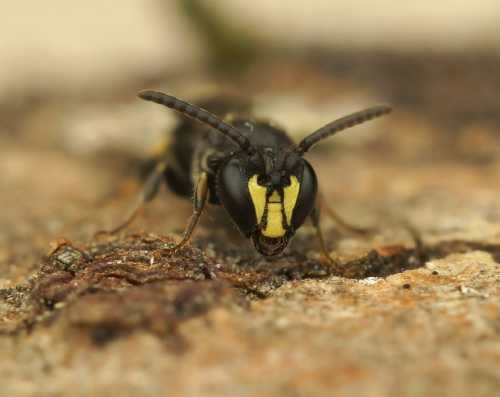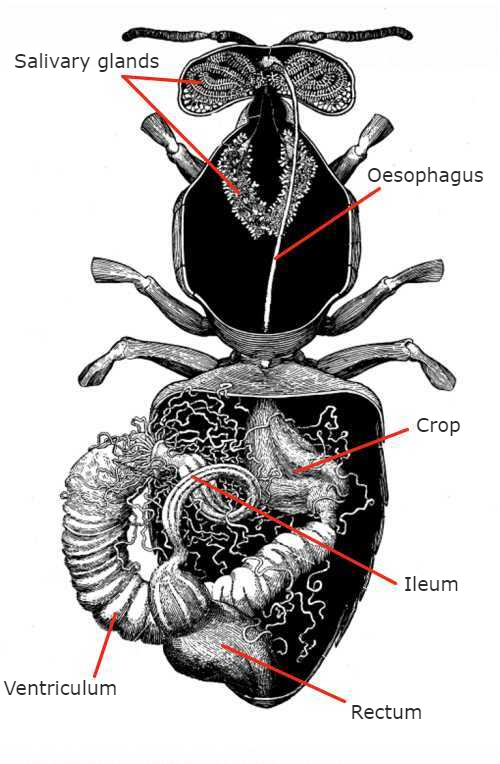Do Solitary Bees Have A Dufours Gland And What Is Its Function?
The short answer is 'yes'.
Solitary bees have a Dufour's gland. It's function varies depending on species.
Here we'll take a broad look at the function of the Dufour's gland in solitary bees.
The Dufour's Gland In Solitary Bees
I have already written about the Dufour’s gland in honey bees.
The Dufour's gland is an exocrine gland which in honey bees, seems to have different functions in queens and workers.
In queen honey bees the Dufour’s gland secretions are part of the complex queen signal, and it is thought that the secretions play a role in helping worker bees distinguish between queen-laid eggs and worker-laid eggs,, and engage in ‘worker policing’1,2,3,4.
On the other hand, in worker honey bees, the Dufour’s gland secretes an alarm pheromone.
Is the function of the Dufour’s gland different in solitary bees?
Whereas honey bee colonies are superorganisms, solitary bees do not function within colonies, and the Dufour’s gland has a number of different functions in solitary bees.
These differences have evolved over the millions of years that bees have been evolving.
Scientists believe that in solitary bees, the function of the Dufour’s gland can broadly include:
- pheromone production (which can have several different communication purposes);
- larval food production;
- production of materials used in nest construction
However, it appears that the function of the Dufour’s gland in solitary bees seems to differ from bee family to bee family5.
Function Of The Dufour's Gland In The Megachilidae Bee Family
 Above: Osmia caerluscens
Above: Osmia caerluscens
This family includes: leafcutter bees (Megachile genus); mason bees (Osmia and Hoplitis genera); wool carder bees (Anthidium genus); Resin bees (Heriades
genus); Sharp-tailed bees (Coelioxys genus); Scissor bees (Chelostoma genus); Dark bees (Stellis genus).
It is thought that in the Megachilidae family, the Dufour’s gland secretions are for brood cell lining, larval food, and nest recognition6,7,8 .
Function Of The Dufour's Gland In The Halictidae Bee Family
This family includes: Sweat bees (Lasioglossum genus); Furrow bees; (Halictus genus and Lasioglossum genera); Blood bees (Sphecodes genus).
In this family, the Dufour’s gland secretions are for brood cell lining, nest strengthening, nest recognition, nestmate and kin recognition, and as a sex hormone 9,10,11,12,13.
Function Of The Dufour's Gland In The Apidae Bee Family
This family includes: Carpenter bees (Xylocopa genus and Ceratina genus); Nomad bees (Nomada genus); Flower bees (Anthropora genus); Long-horned bees
(Eucera genus); Mourning bees (Melecta genus).
In this family, the Dufour’s gland secretions are for forage site marking14.
Function Of The Dufour's Gland In The Andrenidae Bee Family
The Adrenidae family family includes Mining bees (Andrena genus).
In this family, the functions of the Dufour’s gland secretions are brood cell lining9 , nest recognition15 and kin recognition16.
Function Of The Dufour's Gland In The Colletidae Bee Family
The Colletidae family includes Plasterer bees (Colletes genus) and Yellow-faced bees (Hylaeus genus);
According to research, in this family, the functions of the Dufour’s gland secretions are brood cell lining17 and nest recognition.
 Above: Hylaeus communis
Above: Hylaeus communisRead about: The Function Of The Dufour's Gland In Bumble Bees
References
1. Ratnieks F.L.W., Visscher P.K. (1989) ‘Worker policing in honeybees.’ Nature 342: 796-797
2. Oldroyd B.P., Ratnieks F.L.W. (2000) ‘Evolution of worker sterility in honey-bees (Apis mellifera): how anarchistic workers evade policing by laying eggs that have low
removal rates.’ Behav Ecol Sociobiol 47:268–273
3. Katzav-Gozansky T, Soroker V, Ibarra F, Francke W, Hefetz A (2001) ‘Dufour’s gland secretion of the queen honeybee (Apis mellifera): an egg discriminator pheromone
or a queen signal?’ Behav Ecol Sociobiol 51:76–86
4. Ratnieks F.L.W. (1995) ‘Evidence for a queen-produced egg-marking pheromone and its use in worker policing in the honey bee.’ J Apic Res 34:31–37
5. Mitra A. (2013) ‘Function of the Dufour’s gland in social and solitary Hymenoptera.’ Journal of Hymenoptera Research 35: 33-58 (doi: 10.3897/JHR.35.4783)
6. Cane JH, Carlson RG (1984) Dufour’s gland triglycerides from Anthophora, Emphoropsis (Anthophoridae) and Megachile (Megachilidae) bees (Hymenoptera:
Apoidea). Comparative Biochemistry and Physiology B 78: 769–772. (doi:10.1016/0305-0491(84)90132-9)
7. Guédot C, Pitts-Singer TL, Buckner JS, Bosch J, Kemp WP (2006) Olfactory cues and nest recognition in the solitary bee Osmia lignaria. Physiological Entomology Volume
31: 110–119. (doi: 10.1111/j.1365-3032.2005.00490.x)
8. Duffeld RM, Wheeler JW, Eickwort GC (1984) Sociochemicals of bees. In: Bell WJ, Cared RT (Eds) Chemical Ecology of lnsects. Chapman and Hall, London, 387–328.
9. Cane JH (1981) Dufour’s gland secretion in the cell lining of bees (Hymenoptera: Apoidea). Journal of Chemical Ecology 7: 403–410. (doi: 10.1007/BF00995762)
10. Brooks RW, Cane JH (1984) Origin and chemistry of the secreted nest entrance lining of Halictus hesperus (Hymenoptera: Apoidae). Journal of Kansas Entomological
Society 7: 161–165.
11. Ayasse M, Engels W, Hefetz A, Lübke G, Francke W (1990) Ontogenetic patterns in amounts and proportions of Dufour’s gland volatile secretions in virgin and nesting queens of Lasioglossum malachurum (Hymenoptera: Halictidae). Zeitschrift für Naturforschung, C. 45: 709–714.
12. Smith BH, Carlson TG, Frazier J (1985) Identification and bioassay of macrocyclic lactone sex pheromone of the halictine bee Lasioglossum zephyrum. Journal of Chemical Ecology 11: 1447–1456. doi: 10.1007/BF01012144
13. Hefetz A, Bergström G, Tengö J (1986) Species, individual and kin speciic blends in Dufour’s gland secretions of halictine bees chemical evidence. Journal of Chemical Ecology 12: 197–208. doi: 10.1007/BF01045603
14. Frankie GW, Vinson SB (1977) Scent marking of passion flowers in Texas by female Xylocopa virginica texana (Hymenoptera: Anthophoridae). Journal of Kansas Entomological Society 50: 613–625.
15. Hefetz A (1987) The role of Dufour’s gland secretion in bees. Physiological Entomology 12: 243–253. (doi: 10.1111/j.1365-3032.1987.tb00749.x)
16. Ayasse M, Leys R, Pamilo P, Tengö J (1990) Kinship in communally nesting Andrena (Hymenoptera; Andrenidae) bees is indicated by composition of Dufour’s gland secretions. Biochemical Systematics and Ecology 18: 453–460. (doi: 10.1016/0305-1978(90)90092-T).
17. Hefetz A, Fales HM, Batra SWT (1979) Natural polyesters: Dufour’s gland macrocyclic lactones in the brood cell laminesters in Colletes bees. Science 204: 415–417. (doi:10.1126/science.204.4391.415).
If you found this page helpful or interesting, I'd really be grateful if you would share it with others - if not this page, perhaps another, such as Gardening For Bees.
Thank you so much :) .
